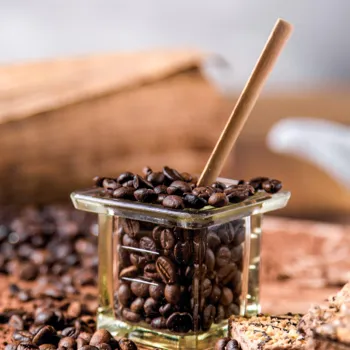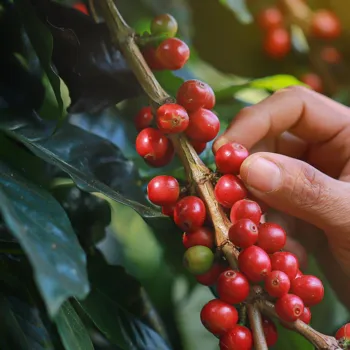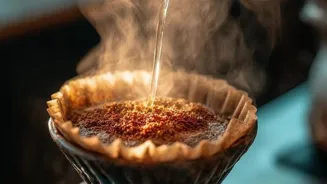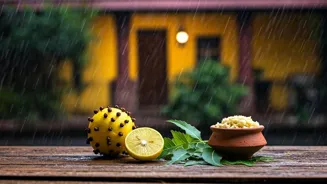Discover the Journey of Coffee: From Bean to Cup - A Desi Perspective. Uncover the secrets behind your favorite brew!
Coffee. Just the word itself conjures images of bustling offices, sleepy mornings, and
cozy cafes. But have you ever stopped to consider the incredible journey that each cup of coffee undertakes before it reaches your eagerly waiting hands?

From the humble coffee bean, nurtured in far-off lands, to the steaming, aromatic beverage we relish, it's a story worth exploring, especially from an Indian perspective.
This article delves into the fascinating process, shedding light on the stages that transform a simple seed into a cherished drink. We will explore the nuances of cultivation, processing, roasting, and brewing, painting a vivid picture of what goes into creating that perfect cup of joe.
This is a desi take, keeping in mind the Indian palate and preferences, exploring coffee not just as a beverage, but as an experience.
The dedication of Indian coffee farmers in cultivating quality beans
The journey begins in the coffee-growing regions, often nestled in the hills of South India – think Coorg, Chikmagalur, and the Nilgiris. Coffee plants thrive in warm, humid climates with well-drained soil.

The process is labour-intensive, relying on the expertise of farmers and their families who have cultivated coffee for generations. Imagine the dedication involved, hand-picking ripe coffee cherries from the branches of the trees. Each cherry holds within it the potential for your morning brew.
Farmers carefully tend to their crops, protecting them from pests and diseases, ensuring optimal sunlight and water. The Indian coffee sector is unique, characterised by small family-owned farms dedicated to environmental sustainability.
Consider the meticulous planning involved, from selecting the right coffee varietal to caring for the plants throughout the year. This initial phase is crucial, as the quality of the beans directly impacts the aroma, flavour, and overall experience.
The Indian coffee farmer's story needs to be told, appreciating their commitment to quality, and understanding the challenges they face in the market.
The cherries are harvested when they reach peak ripeness; a process that requires significant skill, as unripe cherries or overripe cherries would result in defective coffee.
Cherries processed for coffee: wet vs dry methods impact flavor
Once the cherries are harvested, they undergo processing to extract the coffee beans. There are primarily two methods: the wet (washed) process and the dry (natural) process.
The wet process involves removing the outer layer of the cherry, fermenting the beans, and then washing them to remove any remaining pulp. This method typically results in coffee with a cleaner, brighter flavour profile.
The dry process, on the other hand, involves drying the entire cherry in the sun. This lends the coffee a richer, more full-bodied flavour, often with fruity notes. The chosen processing method significantly impacts the final taste of the coffee.
Think of the difference between sun-dried raisins and sulphur-treated raisins. Indian coffee producers often use both techniques, catering to different preferences. The choice of the process would depend on the coffee variety, the climate, and the requirements of the buyer.
The dry process, sometimes called the natural process, produces unique coffee flavour with body, sweetness and complex tastes. The wet process coffees have a lighter body and have a brighter, cleaner taste.
The right drying process prevents the growth of unwanted microorganisms while also ensuring that the beans don't dry too fast since drying too fast would create defects in the coffee. A perfect drying and curing of the coffee cherries requires significant experience.
Roasting coffee beans: art meets science in perfecting flavor
Roasting is where the magic truly happens, transforming the green coffee beans into the aromatic, flavourful beans we recognise. The heat applied during roasting triggers a series of chemical reactions, developing hundreds of flavour compounds.
The roaster carefully monitors the temperature and time, aiming for the perfect roast level. A light roast will preserve the bean's origin characteristics, resulting in a brighter, more acidic cup. A medium roast will offer a balanced flavour profile, with notes of caramel and chocolate.
A dark roast will produce a bold, smoky flavour. Roasting is an art and a science, requiring skill and experience to bring out the best in each bean. In India, a darker roast is traditionally preferred, aligning with our love for strong flavours.
However, there's a growing appreciation for lighter roasts, allowing for a more nuanced tasting experience. Consider the complexity involved in understanding the bean and tailoring the roasting technique to suit that bean.
The roasters have to understand the individual flavour profile of each batch of coffee beans to bring out the best in them with the perfect roasting profile. Roasting requires practice, and is not a mere academic exercise.
Various brewing methods impact coffee flavor profiles significantly
The final step is brewing, where the roasted coffee beans are transformed into the beverage we enjoy. There are numerous brewing methods, each offering a different flavour profile.
From the simplicity of a French press to the precision of an espresso machine, the brewing method can greatly affect the taste of the coffee. A French press will produce a full-bodied cup with a rich texture. A pour-over will highlight the subtle nuances of the bean.
An espresso machine will create a concentrated shot of coffee with a crema. The choice of brewing method depends on personal preference and desired flavour. In India, filter coffee is a beloved tradition, using a metal filter to slowly drip coffee concentrate, often mixed with milk and sugar.
The brewing process is not merely about extracting caffeine; it's about unlocking the full potential of the bean, releasing its aroma and flavour. Consider the attention to detail involved, from the temperature of the water to the grind size of the beans.
Experimenting with different brewing methods can open up a whole new world of coffee experiences. The right water temperature is critical in optimising extraction, too little would result in under extraction, whereas too much would result in over extraction.
Generations nurture coffee journey, respect the process & hands involved
From the coffee farms, cared for by generations of families, through the meticulous stages of processing and roasting, to the final act of brewing – each step is important to the exquisite result.
So, the next time you hold a cup of coffee, take a moment to acknowledge the journey it has undertaken, and the many hands that have contributed to its creation. Its an ode from the ground up to your cup, to the farmers and all those involved in the value chain.
You can appreciate the intricate work involved in making your morning cup of coffee, and respect those who are involved in the process. The Indian coffee story is one of passion, dedication, and a commitment to quality.
AI Generated Content. Glance/InMobi shall have no liability for the content












